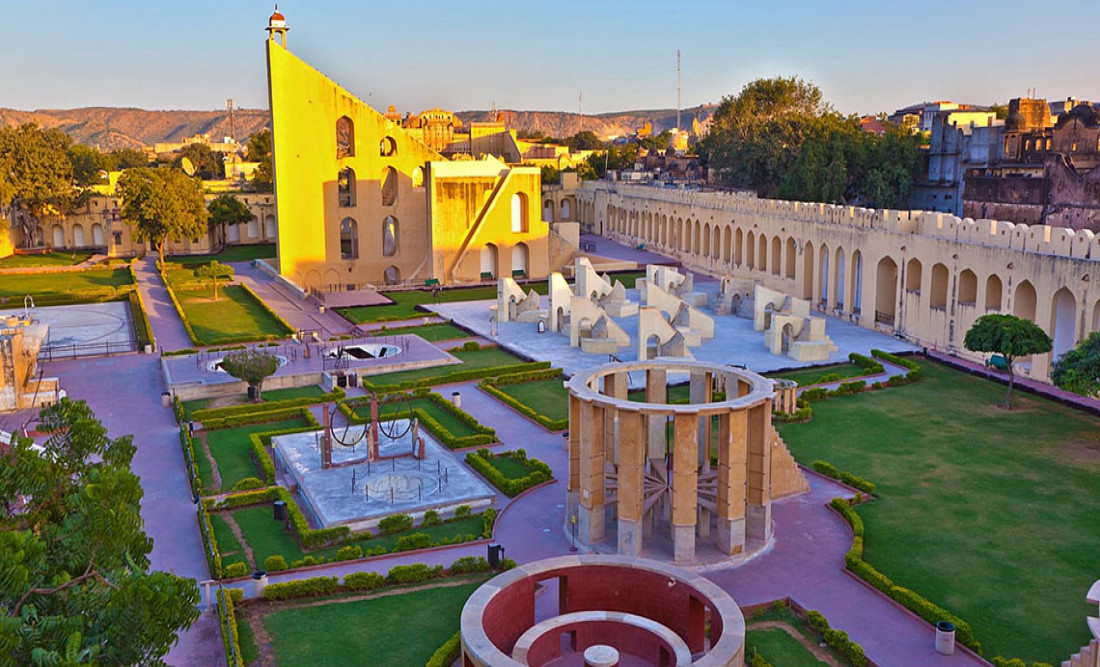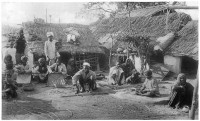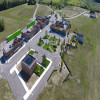Jantar Mantar - World Heritage Site

The Jantar Mantar, Jaipur
The Jantar Mantar, in Jaipur, is an astronomical observation site built in the early 18th century. It includes a set of some 20 main fixed instruments. They are monumental examples in masonry of known instruments but which in many cases have specific characteristics of their own. Designed for the observation of astronomical positions with the naked eye, they embody several architectural and instrumental innovations. This is the most significant, most comprehensive, and the best preserved of India's historic observatories. It is an expression of the astronomical skills and cosmological concepts of the court of a scholarly prince at the end of the Mughal period.
History
Exactly when Jai Singh began construction in Jaipur is unknown, but several instruments had been built by 1728, and the construction of the instruments in Jaipur continued until 1738. During 1735, when construction was at its peak, at least 23 astronomers were employed in Jaipur, and due to the changing political climate, Jaipur replaced Delhi as Jai Singh's main observatory and remained Jai Singh's central observatory until his death in 1743. The observatory lost support under Isvari Singh (r.1743-1750) because of a succession war between him and his brother. However, Mado Singh (r. 1750-1768), Isvari Singh's successor, supported the observatory, although it did not see the same level of activity as under Jai Singh. Although some restorations were made to the Jantar Mantar under Pratap Singh (r.1778-1803), activity at the observatory died down again. During this time, a temple was constructed and Pratap Singh turned the site of the observatory into a gun factory.
Ram Singh (r. 1835-1880) completed restoring the Jantar Mantar in 1876, and even made some of the instruments more durable by inserting lead into the instruments' lines and using stone to restore some of the plaster instruments. However, the observatory soon became neglected again, and was not restored until 1901 under Madho Singh II (r. 1880-1922).
Outstanding Universal Value
Brief synthesis
The Jantar Mantar, Jaipur, is an astronomical observation site built in the early 18th century. It includes a set of some twenty main fixed instruments. They are monumental examples in masonry of known instruments but which in many cases have specific characteristics of their own. The Jantar Mantar is an expression of the astronomical skills and cosmological concepts of the court of a scholarly prince at the end of the Mughal period.
The Jantar Mantar observatory in Jaipur constitutes the most significant and best preserved set of fixed monumental instruments built in India in the first half of the 18th century; some of them are the largest ever built in their categories. Designed for the observation of astronomical positions with the naked eye, they embody several architectural and instrumental innovations. The observatory forms part of a tradition of Ptolemaic positional astronomy which was shared by many civilizations. It contributed by this type of observation to the completion of the astronomical tables of Zij. It is a late and ultimate monumental culmination of this tradition.
Through the impetus of its creator, the prince Jai Singh II, the observatory was a meeting point for different scientific cultures, and gave rise to widespread social practices linked to cosmology. It was also a symbol of royal authority, through its urban dimensions, its control of time, and its rational and astrological forecasting capacities. The observatory is the monumental embodiment of the coming together of needs which were at the same time political, scientific, and religious.
The Jantar Mantar in Jaipur is an outstanding example of the coming together of observation of the universe, society and beliefs. It provides an outstanding testimony of the ultimate culmination of the scientific and technical conceptions of the great observatory devised in the Medieval world. It bears witness to very ancient cosmological, astronomical and scientific traditions shared by a major set of Western, Middle Eastern, Asian and African religions, over a period of more than fifteen centuries.
The Jantar Mantar in Jaipur is an outstanding example of a very comprehensive set of astronomical instruments, in the heart of a royal capital at the end of the Mughal period in India. Several instruments are impressive in their dimensions, and some are the largest ever built in their category.
Integrity and authenticity
The observatory of Jantar Mantar in Jaipur has been affected by its outdoor situation in a tropical area, and then by its temporary abandonment in the 19th century, which has resulted in frequent maintenance interventions and then various restorations over a period of more than a century. Nevertheless, the general integrity of the site has been essentially maintained and partially restored.
On the other hand, establishing the authenticity of each individual instrument is more complex, as a result of the many interventions which have taken place. While authenticity is generally unquestionable with regard to the astronomical function, it is more difficult to establish with regard to plasters, instrument graduations, some architectural interpretations and the immediate landscape environment of elements of the property.
Protection and management measures
The Jantar Mantar is protected under the Rajasthan Monuments Archaeological Site and Antiquities Act, 1961, under Sections 3 and 4. It was designated a monument of national importance in 1968.
The main challenges for the property, which could potentially represent a threat, are controlling the development of tourism, and allowing for urban development in the immediate vicinity of the Jantar Mantar. Major projects to upgrade the district and modify traffic have been announced, and these may affect the buffer zone, and more generally the landscape and cultural environment of the property. It is in particular necessary to specify the measures taken to protect the buffer zone, and to include these measures in the upcoming Master Plan of the municipality of Jaipur. The system for the management of the property is appropriate, provided that it includes a genuinely overarching management body and provided that the Management Plan is promulgated. Furthermore, it is necessary to strengthen the scientific expertise of the bodies in charge of managing the property.

Manoj Bhiva
Manoj Bhiva is a dedicated writer who loves to write on any subject. Manoj Bhiva maintains a similar hold on politics, entertainment, health, abroad articles. Manoj Bhiva has total experience of 3 years in web and Social. Manoj Bhiva works as a writer in Wordict Post.
Russian Rocket 'Totally Destroys' Dorm, Unknown Amount Dead: Zelensky
Posted on 18th Aug 2022









